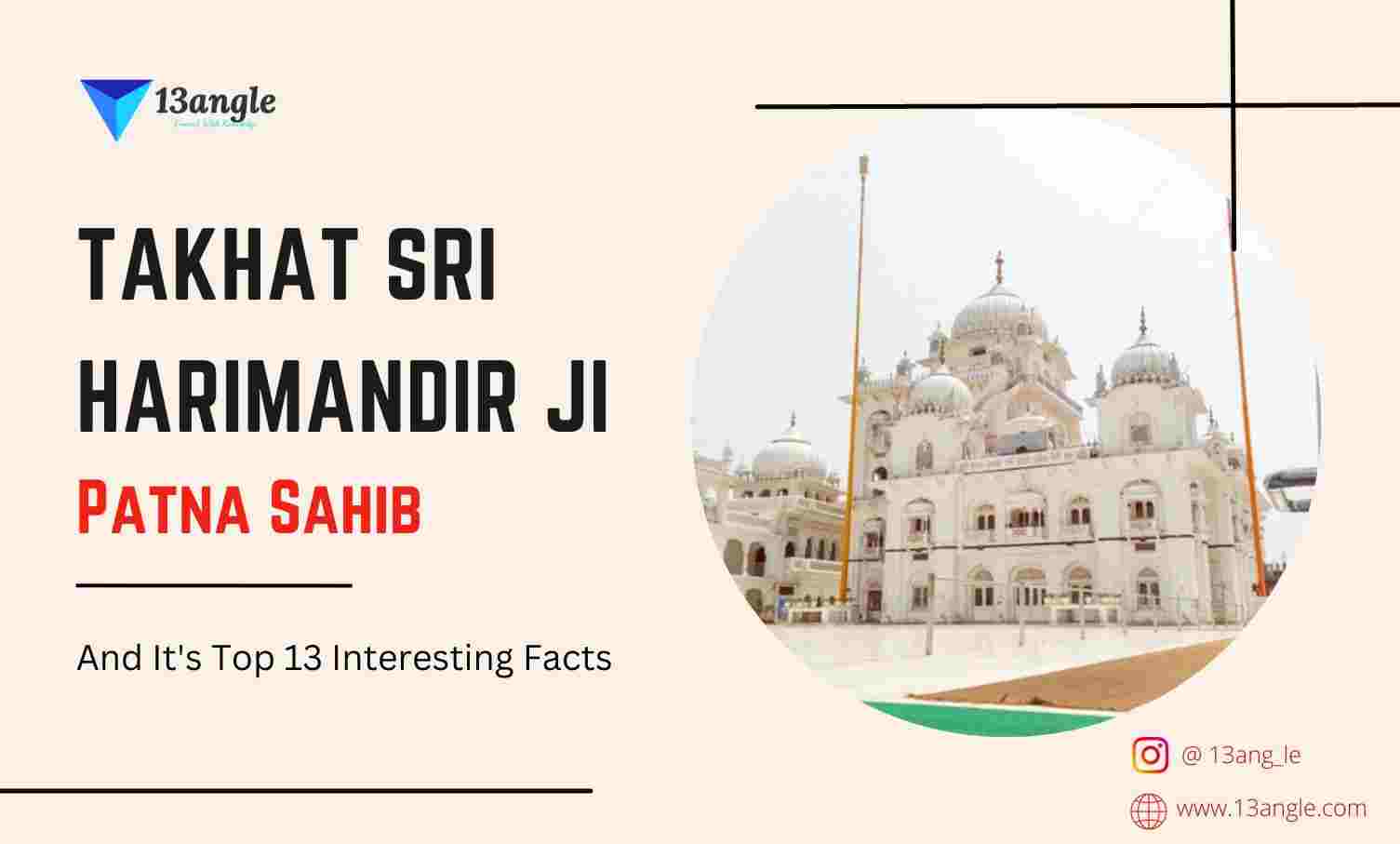- Umang Sagar
- Place, Recent article
Takhat Sri Harimandir Ji, Patna Sahib
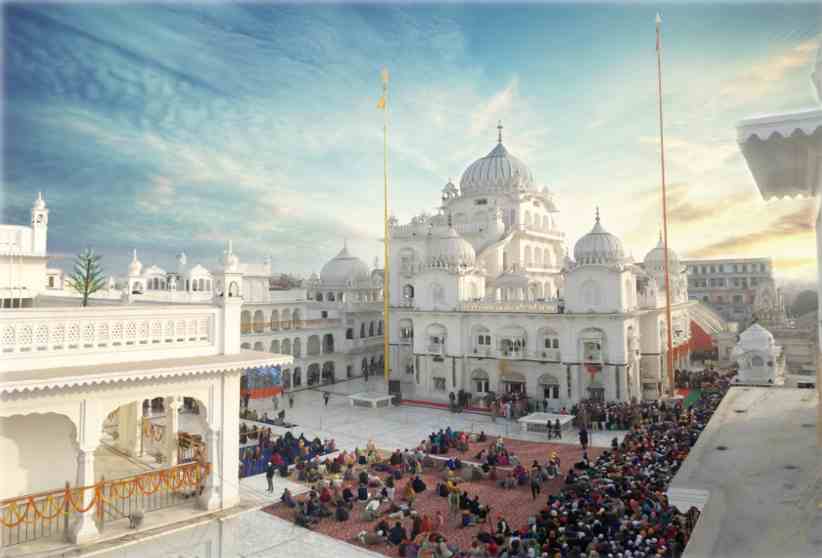
Introduction
-
Takht Sri Harimandir Sahib, also known as Patna Sahib Gurudwara, is one of the five Takhts, or temporal seats of authority, for Sikhs. It is in the city of Patna, in the Indian state of Bihar. The gurdwara, which marks the birthplace of Guru Gobind Singh Ji, the tenth Sikh Guru, is a major pilgrimage site for Sikhs.
-
The complex of Takht Sri Harimandir Sahib includes several buildings, including the main gurdwara, a langar hall, a museum, and a library. The main gurdwara, which is built in a blend of Mughal and Sikh architectural styles, is an impressive structure with intricate carvings and decorations.
-
Sikhs from all over the world visit Takht Sri Harimandir Sahib to pay their respects to Guru Gobind Singh Ji and to seek his blessings. The gurdwara is particularly crowded during important Sikh festivals, such as Guru Gobind Singh Ji’s birth anniversary (known as Prakash Utsav) and the Holla Mohalla festival.
History
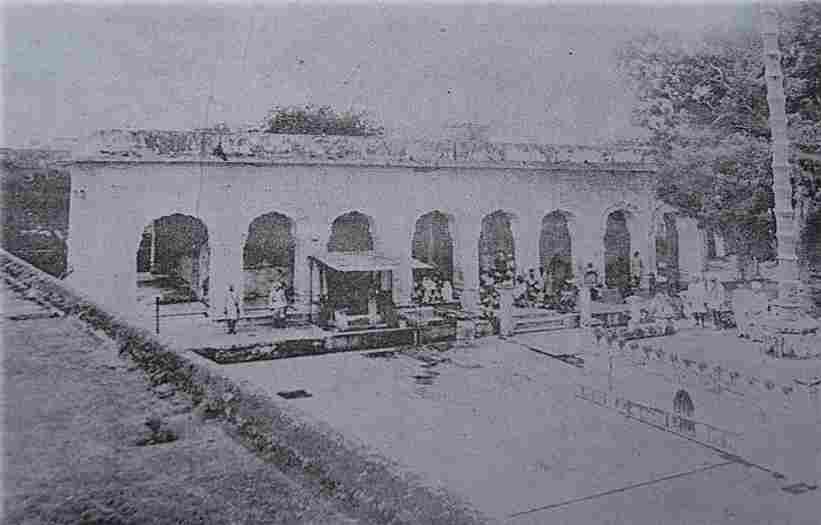
-
The history of Takht Sri Harimandir Sahib dates to the early 16th century, when Guru Nanak Dev Ji, the founder of Sikhism, visited Patna during his third Udasi (missionary journey). There were 64 gates and 670 towers protected by moat and wodden walls. He entered Patna through the western gate and stayed at Bhagat Jaitamal’s House now known as Gurudwara Gai Ghat.
-
During that time, a middle-aged Jeweler of Patna City named Salis Rai Johri was very much influenced by the divine personality of Guru Nanak Ji, through his followers Mardana, requested Guruji to sanctify his home. Salis Rai Johri was also a man of religious bent of mind. Due to his true devotion Guruji accepted his request and stayed for about four months at Salis Rai’s place. A congregational center was established, and people of locality used to attend it daily in the morning and evening. At the time of Guruji’s departure, Salis Rai’s trustee servant Adhraka was appointed as the head of this congregational center with the purpose to continue the propagation of Guruji’s mission. Guruji’s visit laid the foundation for the Sikh community in Patna.
-
Guru Teg Bahadur Ji, the 9th guru of Sikh religion, along with his family members started a preaching tour to the East. In the beginning of 1666 A.D. he reached Patna and stayed at Jaitamal’s house where Guruji had made a center. The 4th successor of Salis Rai’s Sangat namely Ghanshyam the great grandson of Adhraka was also ambitious to get blessings from the 9th successor of Guru Nanak Ji.
-
When he heard of Guru Teg Bahadur Ji’s visit to Patna, he brought Guru Bahadur Ji’s family in a procession from Jaitamal’s House to Salis Rai Johri’s Center (Now the birthplace of Sri Guru Gobind Singh called Takhat Sri Harimandir Ji).
-
Mata Gujri gave birth to Guru Gobind Singh Ji in Harimandir gali, Patna. Guru Govind Singh Ji was born in Patna Paus Sudi 7, Sambat 1723 corresponding to 22nd December 1666 A.D.
-
Guru Gobind Singh Ji mentioned the name of Patna in his autobiography named Bachitra Natak– It was there that my light had appeared i was born at Patna City.
-
The Takhat Sri Harimandir Sahib Gurudwara was built in memory of Guru Gobind Singh Ji, the tenth Sikh Guru. The construction of the gurudwara was completed by Maharaja Ranjit Singh, the Sikh ruler of Punjab, who also established the golden dome on the gurudwara. The Current Shrine of Takhat Sri Harimandir Ji Sahib was built in the 1950s.
-
The gurudwara complex houses several important Sikh shrines, including the main sanctum, which houses the Guru Granth Sahib, the holy scripture of Sikhism. It also houses the Takht Sahib, the throne of authority, where the five Sikh high priests sit and make important decisions related to the Sikh community.
-
The gurudwara has undergone several renovations over the years. In 1934, due to the damages caused by the earthquake the gurudwara building was renovated and a new building was constructed between 1948 and 1957 for around 2000000 rupees. The present structure was constructed in 1954, and it is designed in the architectural style of the famous Golden Temple in Amritsar, Punjab.
-
Today, Takht Sri Harimandir Sahib is a popular pilgrimage site for Sikhs from all over the world. The gurudwara complex has several facilities for the pilgrims, including a langar hall, where free meals are served to all visitors, irrespective of their caste, creed, or religion. The gurudwara is also known for its charitable works and community services.
The Architecture Of Takht Sri Harimandir Patna Sahib
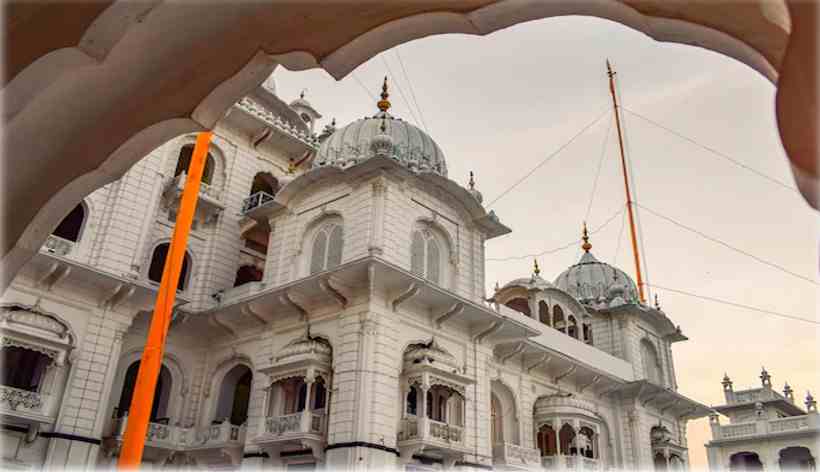
Takht Sri Harimandir Sahib Patna is one of the five Takhts (thrones) of Sikhism and is in the city of Patna, Bihar, India. The architecture of Takht Sri Harimandir Sahib Patna reflects a blend of Hindu and Islamic styles, as well as the unique Sikh style.
The main entrance of the Gurdwara building is through a large gateway known as the “Deorhi.” The Deorhi is made of red sandstone and has intricate carvings and designs. The main prayer hall, known as the “Darbar Sahib,” is located on the first floor of the Gurdwara building and is accessed through a marble staircase. The Darbar Sahib has a large central dome and is surrounded by smaller domes. The walls of the prayer hall are adorned with colourful frescoes depicting scenes from the life of Guru Gobind Singh, the tenth Sikh Guru.
The main building of the Takht Sri Harimandir Patna Sahib is a three-story white marble structure that has four entrances. The building is designed to be symmetrical and topped with a golden dome. The exterior walls of the building are decorated with intricate designs and patterns, which are carved into the marble. The interior of the building is decorated with colourful murals, frescoes, and carvings.
The complex of Takht Sri Harimandir Sahib Patna comprises several buildings, including the main Gurdwara building, a museum, a library, a hospital, and residential quarters. The main Gurdwara building is a double-story structure made of white marble and has a gold-plated dome on top. The dome is surrounded by a gallery, which provides a panoramic view of the surroundings.
The Gurdwara complex also houses a museum, which displays a collection of rare manuscripts, weapons, and other artefacts related to Sikh history. The library at Takht Sri Harimandir Sahib Patna has a vast collection of books and documents related to Sikhism and other religions. The hospital at Takht Sri Harimandir Sahib Patna provides medical services to the community and has state-of-the-art facilities. The residential quarters are provided for the Sikh community and pilgrims visiting the Gurdwara.
The main prayer hall of the Takht Sri Harimandir Patna Sahib is called the Diwan-i-Khas. It is a large rectangular hall with a high ceiling, which is supported by pillars. The walls of the hall are decorated with intricate carvings and paintings that depict scenes from Sikh history. At the end of the hall is the throne of Guru Gobind Singh Ji, which is decorated with gold and precious stones.
Another important feature of the Takht Sri Harimandir Patna Sahib is the Langar Hall. This is a large hall where free meals are served to all visitors, regardless of their religion or social status. Langar Hall is designed to be a place where people of all backgrounds can come together and share a meal.
The Takht Sri Harimandir Patna Sahib also has a museum that houses a collection of artefacts related to Sikh history, including weapons, manuscripts, and paintings. The museum also has a library that contains a large collection of books and manuscripts related to Sikhism.
The architecture of Takht Sri Harimandir Sahib Patna is a unique blend of different styles, reflecting the cultural and historical influences on the Sikh community. The Gurdwara complex is a testament to the rich heritage of Sikhism and serves as a place of worship, education, and community service.
Tenth Guru Gobind Singh Ji Maharaj
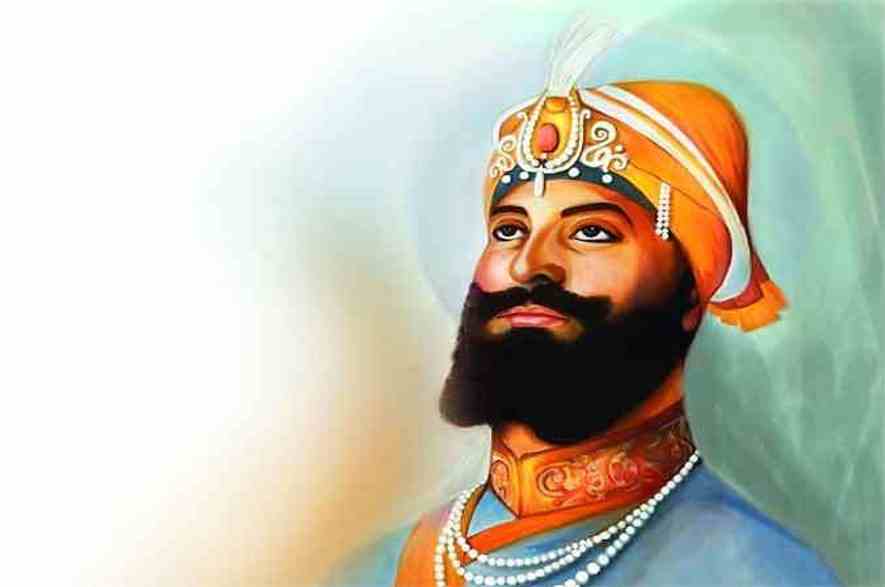
Guru Gobind Singh Ji, also known as Gobind Rai or Gobind Das, was the tenth Sikh Guru and the last of the human Sikh Gurus. He was born in Patna Sahib, Bihar, India, on December 22, 1666. He spent about six and half years of his childhood here in Patna. His father, Guru Tegh Bahadur, was the ninth Sikh Guru.
Guru Gobind Singh Ji’s teachings emphasized the importance of self-discipline, moral courage, and devotion to God. He was a skilled warrior and philosopher who fought against oppression and tyranny and preached the equality of all people. He established the Khalsa, a community of initiated Sikhs who follow the Five Ks and are committed to the principles of Sikhism. The Five Ks are Kesh (uncut hair), Kangha (comb), Kara (steel bracelet), Kachera (shorts), and Kirpan (sword).
He also compiled and finalized the Sikh holy scripture, the Guru Granth Sahib, and declared it the eternal Guru of the Sikhs.
He passed away on October 7, 1708, in Nanded, Maharashtra, India. His legacy lives on through the Sikh community and his teachings, which continue to inspire people all over the world.
Bal Leela, Takhat Sri Harimandir Ji, Patna Sahib
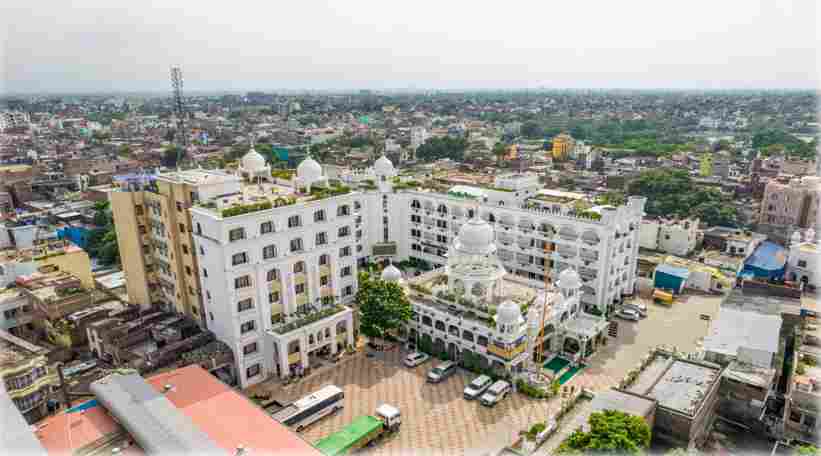
Bal Leela is a term used to describe the playful activities of young Guru Gobind Singh Ji, the tenth Sikh Guru, as a child. These stories are often shared among Sikhs to highlight the Guru’s unique qualities and spiritual nature, even as a young boy. The story of Bal Leela at Patna Sahib is particularly significant for Sikhs. According to legends, young Guru Gobind Singh Ji displayed miraculous powers from an early age. As a child, he was known for his extraordinary intelligence and spiritual insight, and he often amazed his teachers and peers with his knowledge and wisdom.
One of the most famous stories from Bal Leela at Patna Sahib involves a confrontation between young Guru Gobind Singh Ji and a group of local thugs who were harassing the people of the village. According to legend, the Guru challenged the thugs to a wrestling match and defeated them all using his supernatural strength and agility. Other stories from Bal Leela at Patna Sahib describe the Guru’s encounters with animals, his early interest in poetry and music, and his profound spiritual experiences.
Today, Takhat Sri Harimandir Ji in Patna Sahib’s Bal Leela is a popular pilgrimage site for Sikhs from around the world. Visitors come to pay their respects to Guru Gobind Singh and to participate in religious ceremonies and festivals throughout the year.
Kangan Ghat Patna Sahib
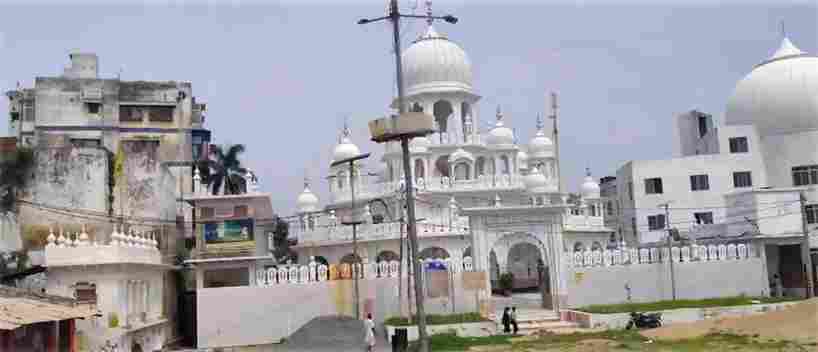
One of the important events in Guru Gobind Singh’s life took place in Kangan Ghat, Patna Sahib.
The story goes that Guru Gobind Singh was traveling to Patna with his family and a group of Sikhs when they came across a poor family. The family had two daughters, who were being forced to marry a Muslim man against their will. Guru Gobind Ji saw the plight of the girls and offered to help.
He asked his Sikhs to build a fortification around the area where the wedding was to take place. When the Muslim party arrived, they were met with fierce resistance from the Sikhs. A battle ensued, and the Sikhs managed to hold off the attackers until the wedding party escaped.
The Guru then took the two girls under his protection and brought them to his camp. He announced that he had adopted them as his daughters and that they were to be known as Sahib Kaur and Fateh Kaur. He also announced that anyone who wanted to join the Khalsa, the community of baptised Sikhs, could do so by taking Amrit, the nectar of initiation.
The event at Kangan Ghat is significant because it marked the establishment of the Khalsa and the initiation of the Five Beloved Ones, the first five Sikhs to take Amrit and form the nucleus of the Khalsa. The event is celebrated every year on Baisakhi, which falls on the 14th of April. Today, the site is known as Takht Sri Patna Sahib and is one of the most important pilgrimage sites for Sikhs.
Langar
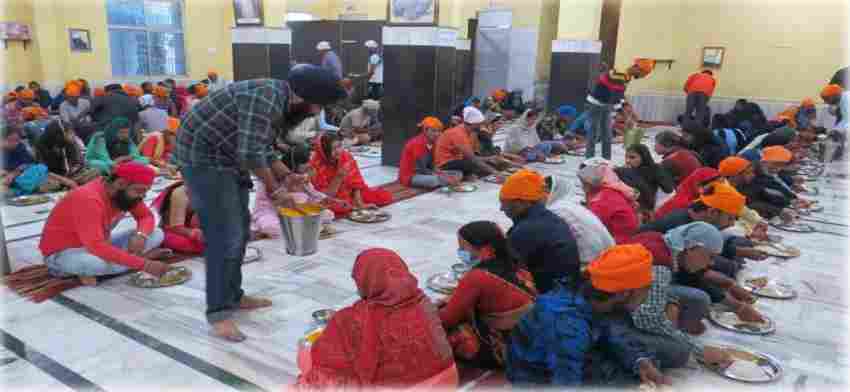
Langar is a term used in Sikhism to refer to the free community kitchen service provided at Gurdwaras (Sikh places of worship) around the world. It is a central part of Sikhism, reflecting the principle of equality and the importance of community service. One of the most famous and significant places for Langar in India is Takhat Sri Harimandir Ji, Patna Sahib.
Langar at Takhat Sri Harimandir Ji, Patna Sahib, is one of the largest and most well-organized community kitchens in India. It is open 24 hours a day and serves free meals to everyone, regardless of their religion, caste, or creed. The Langar can accommodate up to 5,000 people at a time, and during special occasions, it can serve up to 10,000 people. The food is prepared by a team of volunteers who work tirelessly to ensure that everyone who visits the Gurdwara is well-fed.
It serves a variety of vegetarian dishes, including roti (Indian bread), sabzi (vegetables), daal (lentils), and kheer (sweet rice pudding). The food is prepared in the Langar kitchen, which is a large and well-equipped facility with modern cooking equipment. The Langar also has separate seating areas for men and women, and everyone is expected to sit on the floor as a symbol of equality and humility.
It is run entirely by volunteers, who come from all walks of life and backgrounds. They are responsible for cooking, cleaning, serving, and managing the Langar, and they work in shifts to ensure that the Langar is always open and ready to serve. The Langar is funded entirely by donations from the Sikh community and other donors who wish to support this important community service.
Prakash Utsav At Takhat Sri Harimandir Ji, Patna Sahib
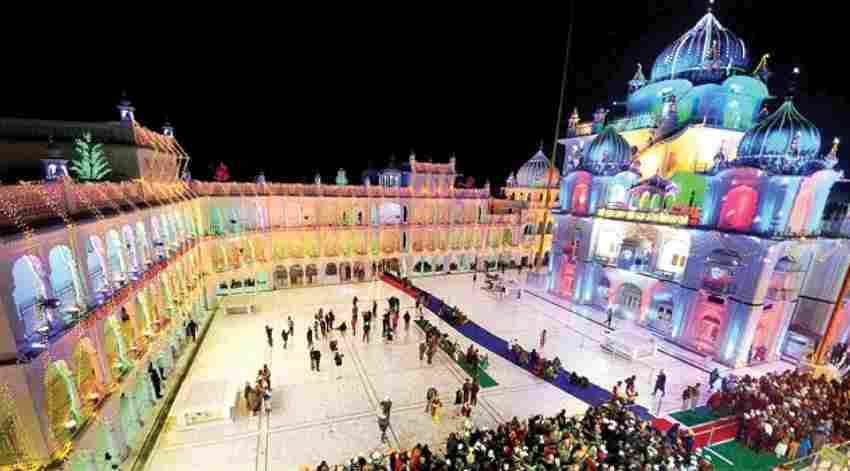
- Prakash Utsav, also known as Prakash Parv, is a celebration that commemorates the birth anniversary of Guru Gobind Singh Ji, the tenth Sikh Guru. The festival is celebrated by Sikhs all over the world, and one of the most significant celebrations takes place at Takhat Sri Harimandir Ji, Patna Sahib, in Bihar, India.

The Prakash Utsav celebrations at Takhat Sri Harimandir Ji, Patna Sahib, usually take place from December 31 to January 2.
The celebrations begin with a Nagar Kirtan, a Sikh procession that is led by the Panj Pyare, five beloved ones who were the first members of the Khalsa, the community of initiated Sikhs created by Guru Gobind Singh Ji. The Nagar Kirtan is a colorful and joyous event, with participants singing hymns and carrying the Sikh flag, the Nishan Sahib.
On the second day of the celebrations, a special prayer called Akhand Path is held. This is a continuous reading of the Sikh holy book, the Guru Granth Sahib, which takes around 48 hours to complete. The reading is done by a team of Sikh scholars, and devotees can visit the gurdwara to listen to the recitation and offer their prayers.
The third day of the celebrations is the main day of Prakash Utsav, which marks the actual birth anniversary of Guru Gobind Singh Ji. On this day, a special prayer called the Bhog ceremony is held, which marks the completion of the Akhand Path. The ceremony is followed by a Kirtan Darbar, which is a devotional singing event where hymns from the Guru Granth Sahib are sung.
Throughout the Prakash Utsav celebrations langar, or community meals, are served to all visitors, regardless of their religion or background. This is a Sikh tradition that reflects the belief in equality and sharing.
Overall, the Prakash Utsav celebrations are a joyous and festive occasion for Sikhs as they come together to honor the birth anniversary of Guru Gobind Singh Ji and his contributions to the Sikh faith.
Prakash Parv 350th
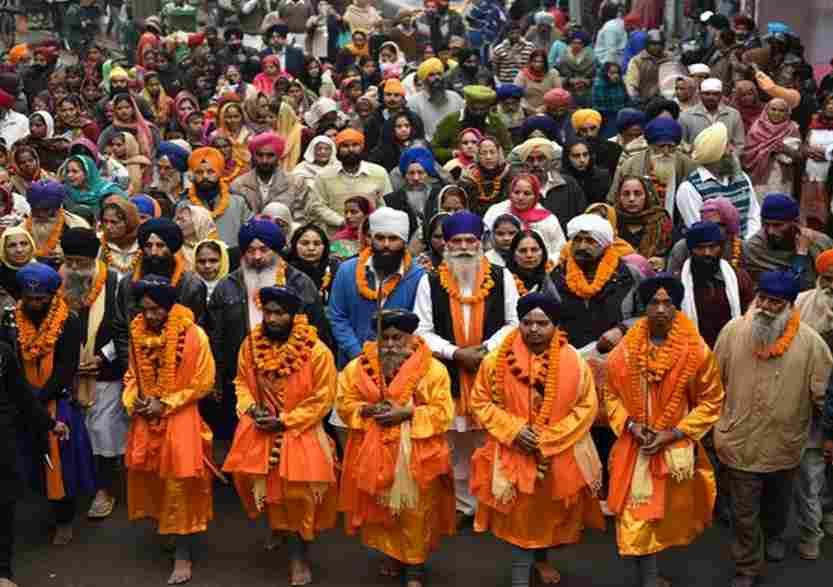
- The 350th Prakash Parv, also known as the 350th Birth Anniversary, of Guru Gobind Singh Ji was celebrated at Takht Sri Patna Sahib in Patna, Bihar, India, from December 30, 2016, to January 8, 2017. The event was a significant milestone for the Sikh community worldwide, as it marked the birth anniversary of the tenth Sikh Guru, Guru Gobind Singh Ji.
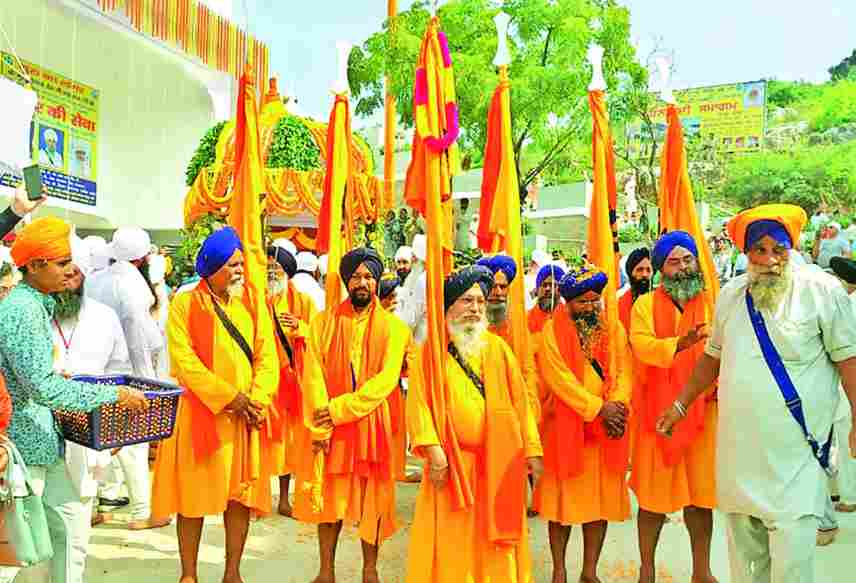
The 350th Prakash Parv celebrations at Takht Sri Patna Sahib were a grand affair, with elaborate arrangements made to welcome the devotees. The event was inaugurated by the Prime Minister of India, Shri Narendra Modi, who also paid his respects at the Gurudwara. The Bihar government had made significant efforts to ensure the smooth functioning of the event, with various facilities provided for the devotees, including accommodation, transportation, and medical facilities.
Several cultural programs and religious events were organized during the celebrations, which included recitations of the Guru Granth Sahib, kirtans, and langar’s. A procession was also held on January 5, 2017, which saw thousands of devotees participating in a Nagar Kirtan, or religious procession. The procession started from Takht Sri Patna Sahib and ended at Harimandir Sahib, which is also known as the Golden Temple, in Amritsar, Punjab.
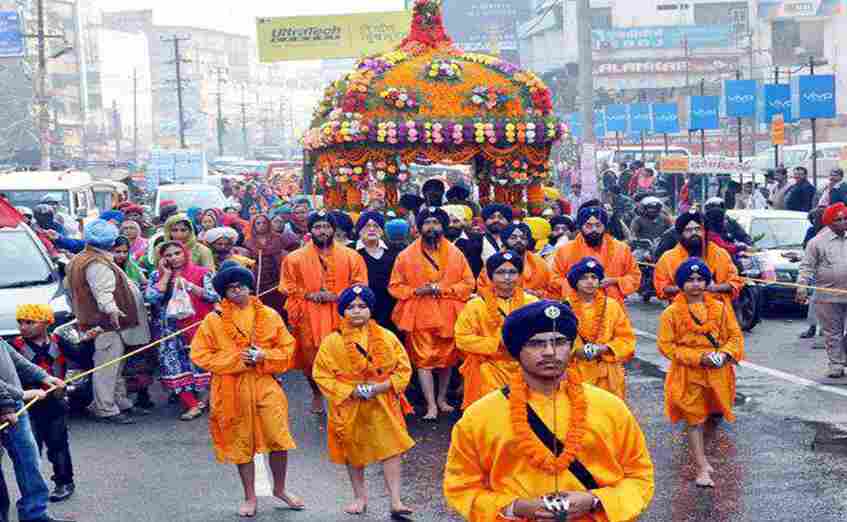
The event also saw the launch of several initiatives, including the Prakash Utsav App, which provided information about the event, and the launch of a new train, the Shatabdi Express, which was dedicated to the 350th Prakash Parv celebrations.
Overall, the 350th Prakash Parv celebrations at Takht Sri Patna Sahib were a grand success, with devotees from around the world coming together to celebrate the birth anniversary of Guru Gobind Singh Ji. The event showcased the rich cultural heritage of Sikhism and provided an opportunity for people to come together and celebrate the teachings of Guru Gobind Singh Ji.
Recent 357th Prakash Parv
The 357th Prakash Parv of Guru Gobind Singh was celebrated at Takht Sri Patna Sahib on January 2023. The festivities were spread over several days and included a series of religious and cultural programs.
The celebrations began with the Akhand Path, a continuous reading of the Guru Granth Sahib, the holy book of the Sikhs, which lasted for three days. The event was attended by thousands of devotees from across the country and around the world.
On the fourth day, a Nagar Kirtan, or a religious procession was taken out from Takht Sri Patna Sahib, which covered various parts of the city. The procession was accompanied by the rhythmic beating of drums, the chanting of hymns, and the singing of devotional songs.
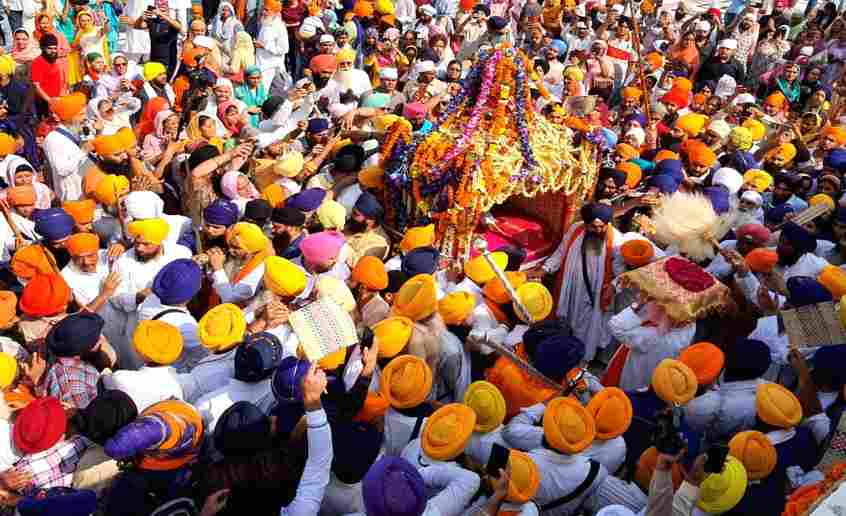
The main event of the Prakash Parv celebrations was held on the fifth day, which marked the birth anniversary of Guru Gobind Singh. On this day, the gurudwara was decorated with lights, flowers, and colorful fabrics, and a special prayer ceremony was held to honor the Guru.
The celebrations included various cultural programs such as traditional Sikh music and dance performances, poetry recitals, and lectures on the life and teachings of Guru Gobind Singh.
Throughout the celebrations, langar’s or community kitchens were set up to serve free food to all the visitors, regardless of their caste, creed, or religion. This tradition is an integral part of Sikhism, which emphasizes the importance of sharing and caring for others.
Prakash Parv at Takht Sri Harimandir Sahib Patna Sahib is an important event for the Sikh community, and it provides an opportunity for devotees to come together and celebrate the life and teachings of Guru Gobind Singh.
Management Of Takhat Sri Harimandir Ji, Patna Sahib
The management of Takht Sri Harimandir Ji is overseen by the Shiromani Gurdwara Parbandhak Committee (SGPC), which is the apex body responsible for managing all Sikh gurdwaras and institutions across India.
The SGPC is responsible for ensuring the proper functioning and upkeep of the gurdwara complex, which includes the main shrine, langar hall, accommodations for pilgrims, and other associated facilities. The management of the gurdwara complex also involves organising and coordinating various religious ceremonies, including daily prayers, kirtans, and special events such as festivals and weddings.
In addition to the SGPC, there is also a local management committee that oversees the day-to-day affairs of the gurdwara complex, including security, cleanliness, and the administration of the langar hall. This committee is appointed by the SGPC and is responsible for ensuring that the facilities are well-maintained and accessible to all visitors.
The management of Takht Sri Harimandir Ji is guided by the principles of Sikhism, which emphasize equality, selfless service, and devotion to God. The goal of the management is to create a welcoming and inclusive environment where all visitors can come to pray, learn, and connect with the teachings of Sikhism.
Renovation related works

In recent years, there have been efforts to renovate and beautify the gurdwara. The Bihar government allocated funds for the renovation of the gurdwara, and a plan was made to improve the infrastructure, cleanliness, and security of the complex.
The renovation work is being carried out under the supervision of the Shiromani Gurdwara Parbandhak Committee (SGPC), which is responsible for the management of gurdwaras across India.
The SGPC has been working closely with the Bihar government to ensure that the renovation work is carried out in a manner that is respectful of the religious and cultural significance of the gurdwara.
Overall, the renovation of Takht Sri Patna Sahib is aimed at improving the facilities and services provided to visitors while also preserving the heritage and history of the site.
Jathedars

Jathedars (also spelt Jathedar) are respected Sikh leaders who are appointed to head certain religious institutions or organizations, such as gurudwaras (Sikh temples). The Jathedars are responsible for overseeing the management and administration of the gurudwara, as well as ensuring that Sikh religious practices are followed properly.
There are five Jathedars who hold significant religious authority in the Sikh community, collectively known as the “Panj Pyare” or “Five Beloved Ones”. These Jathedars are appointed by the Shiromani Gurdwara Parbandhak Committee (SGPC), which is the largest organization responsible for the management of gurudwaras in India.
The Jathedars of gurudwaras are responsible for overseeing various religious activities and ceremonies, including the recitation of the Guru Granth Sahib (the Sikh holy book), the celebration of religious festivals, and the performance of other religious rites and rituals. They are also expected to serve as spiritual leaders and provide guidance to the Sikh community.
Overall, the Jathedars play an important role in ensuring the proper functioning of gurudwaras and in upholding the values and principles of the Sikh faith.
- The list of the Jathedars of Takhat Sri Harimandir ji, Patna sahib are as follows:
- Iqbal Singh (—2019)
- Ranjit Singh (2019- 2022)
- Baldev Singh (2022- incumbent)
Presidents
- This is a list of presidents of the Takhat Sri Harimandir Ji, Patna Sahib Prabandhak Committee as follows:
|
| Tenure
| |
No. | Name | Start | End |
1. | Lakhbir Singh | 1956 | 1959 |
2. | Surjit Singh Majithia | 1959 | 1962 |
3. | Bakhshish Singh Dhillon | 1962 | 1964 |
4. | Gian Singh Purewal | 1964 | 1967 |
5. | Jagjit Singh Grewal | 1967 | 1970 |
6. | Sohan Singh Raees | 1970 | 1973 |
7. | Gian Singh Purewal | 1973 | 1976 |
8. | Jaswant Singh Khochhar | 1976 | 1980 |
9. | Surjit Singh Majithia | 1980 | 1982 |
10. | Nirlep Kaur | 1982 | 1984 |
11. | Joginder Singh Jogi | 1984 | 1993 |
12. | Surendrajeet Singh Ahluwalia | 1994 | 2000 |
13. | Mahender Singh Romana | 2001 | 2012 |
14. | R.S. Gandhi | 2012 | 2015 |
15. | Avtar Singh Makkar | February 2015 | October 2018 |
16. | Avtar Singh Hit | October 2018 | 6 September 2022 |
17. | Jagjot Singh Sohi (Acting) | 2022 | incumbent |
Travelling From Other Parts Of India To Takht Sri Harimandir Sahib Patna Sahib
Here are some ways to visit Takht Sri Harimandir Sahib Patna Sahib from other parts of the country:
1. By air: The nearest airport to Patna is Jay Prakash Narayan International Airport, which is well-connected to major cities across India. From the airport, you can take a taxi or a bus to reach the gurdwara.
2. By train: Patna Junction is the main railway station in the city and is well-connected to major cities across India.
Patna Sahib railways station is the local station and is situated near the gurudwara.
From the station, you can take a taxi or an autorickshaw to reach the gurdwara.
3. By bus: Patna is well connected to other parts of the country by road. You can take a state-run or private bus to reach the city. Once you reach Patna, you can take a taxi, an auto-rickshaw, or a local bus to reach the gurdwara.
4. By car: You can also drive to Patna from other parts of the country. The city is well connected to major cities through a network of highways. From the city, you can take a taxi or an autorickshaw to reach the gurdwara.
- Once you reach Takht Sri Harimandir Sahib Patna Sahib, you can pay your respects and participate in the religious ceremonies and rituals held there. It is advisable to dress modestly and cover your head before entering the gurdwara.
Famous Enlightening Quotes By Guru Gobind Singh Ji
- Guru Gobind Singh Jayanti commemorates his birth anniversary, which falls in January or December according to the Gregorian Calendar. Some enlightening quotes by Guru Gobind Singh Ji given below:
1. “Recognize the whole human race as one.”
2. “The greatest comforts and lasting peace are obtained when one eradicates selfishness from within.”
3. “One who calls himself a Sikh of the Guru, the True Guru, shall rise in the early morning hours and meditate on the Lord’s Name.”
4. “All humans are equal in the eyes of God.”
5. “He who regards all men as equals is religious.”
6. “Those who have loved are those that have found God.”
7. “Let no man in the world live in delusion. Without a Guru, none can cross over to the other shore.”
8. “When all other means have failed, it is righteous to take up the sword.”
9. “The sword which kills the flesh is less to be feared than the sword which kills the spirit.”
10. “The Khalsa is my family and I am the father of the Khalsa.”
11. “I came into the world charged with the duty to uphold the right in every place, to destroy sin and evil… the only reason I took birth was to see that righteousness may flourish, that good may live, and tyrants be torn out by their roots.”
12. “The greatest comforts and lasting peace are obtained when one eradicates selfishness from within.”
13. Sach kahon sun leho sabai jin prem kio tin hee prabh paio
“I’lI tell the truth; listen everyone. Only those who have Loved, will realize the Lord.”
14. Har aan kas ki o rastbaazi kunad Rahim-e bar o rehmsaazi kunad
“Those who follow the path of truth in their thought and action, He showers mercies upon them, They are granted his compassion.”
15. “He who has no faith in himself can never have faith in God.”
16. “In egotism, one is assailed by fear, he passes his life totally troubled by fear.”
17. “Blessed, blessed is the True Guru, who has given the supreme gift of the Name of the Lord.”
18. “The Lord Himself reveals the Path, He Himself is the Doer of deeds.”
19. “Meeting the True Guru, hunger departs, hunger does not depart by wearing the robes of a beggar.”
20. “I fall at the feet of those who meditate on the Truest of the True.”
21. “Shed not recklessly the blood of another with thy sword, lest the Sword on High falls upon thy neck.”
22. “Those who worship and adore the Lord through the Guru’s Word forget all their pain and suffering.”
23. “I am a sacrifice to the Guru, who has totally cured me of the fatal disease of egotism. Glorious and great are the virtues of the Guru, who has eradicated evil, and instructed me in virtue.”
24. “In the City of Death, there is pitch darkness and huge clouds of dust, neither sister nor brother is there. This body is frail, old age is overtaking it.”
These quotes by Guru Gobind Singh Ji emphasize the importance of unity, selflessness, meditation, equality, and spiritual growth.
Guru Gobind Singh Jayanti 2023: Wishes and Messages
- Here are some wishes and messages you can use for Guru Gobind Singh Jayanti 2023:
May the teachings of Guru Gobind Singh Ji inspire you to be fearless and stand up for what is right. Happy Guru Gobind Singh Jayanti!
May the teachings of Guru Gobind Singh Ji guide you towards a path of righteousness and selflessness. Happy Guru Gobind Singh Jayanti!
On this auspicious occasion of Guru Gobind Singh Jayanti, may his blessings always be with you and your family. Happy Guru Gobind Singh Jayanti!
Let us celebrate the birth of Guru Gobind Singh Ji and take inspiration from his teachings of bravery, sacrifice, and compassion. Happy Guru Gobind Singh Jayanti!
May the light of Guru Gobind Singh Ji’s wisdom always guide you toward the right path in life. Happy Guru Gobind Singh Jayanti!
Let us follow the path of truth and righteousness, just like Guru Gobind Singh Ji did. Happy Guru Gobind Singh Jayanti!
May Guru Gobind Singh Ji’s teachings of love, peace, and unity bring harmony and happiness to your life. Happy Guru Gobind Singh Jayanti!
Let us remember Guru Gobind Singh Ji’s message of universal brotherhood and work towards creating a world full of love and compassion. Happy Guru Gobind Singh Jayanti!
On the auspicious occasion of Guru Gobind Singh Jayanti, may the teachings of the great guru guide us toward a life of love, kindness, and compassion. Happy Guru Gobind Singh Jayanti!
On this special day, let us remember the sacrifices made by Guru Gobind Singh Ji and his followers, and let us strive to live our lives with the same dedication and devotion. Happy Guru Gobind Singh Jayanti!
FAQs
Takht Sri Harimandir Sahib Patna Sahib is one of the five Takhts or holy seats of authority of the Sikh religion. It is in Patna City, Bihar, India.
Takht Sri Harimandir Sahib Patna Sahib was built to commemorate the birthplace of Guru Gobind Singh, the tenth Sikh Guru. Guru Gobind Singh was born in Patna on December 22, 1666 and spent his early years here. The shrine was constructed in the early 20th century.
Takht Sri Harimandir Sahib Patna Sahib is a place of great religious significance for Sikhs. It is one of the five Takhts or holy seats of the authority of the Sikh religion and is the place where Guru Gobind Singh was born and spent his early years.
Visitors to Takht Sri Harimandir Sahib Patna Sahib are required to cover their heads, remove their shoes, and dress modestly.
No, there is no entry fee for visiting Takht Sri Harimandir Sahib Patna Sahib.
Yes, there are several accommodation options near Takht Sri Harimandir Sahib Patna Sahib, ranging from budget hotels to luxury resorts.
Some other places of interest near Takht Sri Harimandir Sahib Patna Sahib include the Mahavir Mandir, the Gandhi Maidan, and the Patna Museum.
Yes, there are several guesthouses and hotels available for visitors near Takht Sri Harimandir Sahib Patna Sahib.
The best time to visit Takht Sri Harimandir Sahib Patna Sahib is during the winter months (November to February) when the weather is pleasant, and the festival of Guru Gobind Singh’s birth anniversary is celebrated with great enthusiasm.
Yes, photography inside the Takht is prohibited. However, visitors can take photographs outside the premises.
Yes, the Gurdwara is open to people of all faiths and backgrounds. Visitors are expected to cover their heads, remove their shoes, and dress modestly out of respect for the Sikh traditions.
Top 13 Interesting Facts About Patna Sahib
-
Takht Sri Patna Sahib is one of the five Takhts or Holy Thrones of Sikhism, located in the city of Patna, in the state of Bihar, India.
-
It is the birthplace of the tenth and the last Sikh Guru, Guru Gobind Singh Ji, who was born on December 22, 1666.
-
The Gurdwara in Takht Sri Patna Sahib was re-built in the 1950s by the Patna Improvement Trust.
-
The Gurdwara is a white building with golden domes and has a large entrance called the Darshani Deorhi.
-
The main hall of the Gurdwara is decorated with intricate frescoes and has a marble platform where the Guru Granth Sahib (the Sikh holy scripture) is kept.
-
The Gurdwara has a museum that houses relics of Guru Gobind Singh Ji, including a handwritten copy of the Guru Granth Sahib, his sword, and his turban.
-
The Gurdwara also has a well, called the Mata Ganga Ji Well, which is believed to have healing powers.
-
Takht Sri Patna Sahib is an important pilgrimage site for Sikhs from all over the world, and thousands of Sikhs visit the Gurdwara every year.
-
The Gurdwara also has a langar hall, where free food is served to all visitors, regardless of their religion or social status.
-
The Gurdwara celebrates several important Sikh festivals, including Guru Nanak Jayanti, Vaisakhi, and Diwali.
-
In addition to the Gurdwara, there are several other Sikh historical sites in Patna, including the Harimandir Sahib (also known as the Takht Sri Harimandir Sahib), which is where Guru Gobind Singh Ji spent his childhood.
-
The Bihar government has declared Takht Sri Patna Sahib a protected monument under the Bihar Ancient Monuments and Archaeological Sites Remains and Art Treasure Act, 1976.
-
The Gurdwara is open to visitors every day from early morning until late at night, and there is no entry fee. Visitors are expected to cover their heads and remove their shoes before entering the Gurdwara.



